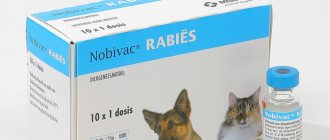In order not to die, you need to know everything about rabies
In order for you to find out the answers to all your questions, you will have to dive deeper into the topic. Well-known veterinary medicine (veterinary medicine) is an area of scientific knowledge and practical activity aimed not only at combating animal diseases, but also at protecting people from zooanthroponoses , producing sanitary-quality animal products and solving veterinary and sanitary problems of environmental protection.
Zooanthroponoses are diseases common to animals and people, in which the source of pathogens for humans is our little brothers. That's why…
The main goal of combating the rabies virus among animals is primarily to protect people!
What is the vaccine for?
Specialized medications allow your puppy to develop immunity to this virus. This allows them to avoid infection through contact with sick individuals, including bites (subject to repeated administration of the serum).
The rabies vaccine makes it possible to avoid transmission of the virus through your pet to other animals and people. For this reason, it is required to be administered to all animals when traveling abroad, before participating in matings, exhibitions and other events. The absence of an immunization note in a pet’s card is a good reason for it not being allowed to participate in competitions.
Who gives birth to painful death?
Rabies (from Latin rabies - “rabies”, from ancient Greek “water, fear”, i.e. hydrophobia, hydrophobia) is a fatal viral disease.
Structure of the rabies virus
The causative agent of rabies is a neurotropic virus (Rabies virus) that affects nerve cells in the spinal cord and brain. Because of this, the rabies virus is accessible to the immune cells of a dog or cat only at the time of the bite when the blood vessels are damaged. Therefore, only during this period can the protective cells created after the vaccine work. However, if the vaccination was not initially given or emergency assistance was not provided immediately after the bite, then the virus subsequently enters the nerve cells, where the body can no longer provide a protective response, since this is only possible within the circulatory system.
But the virus has a “weak point” - it is very unstable in the external environment: it dies in 15 minutes when heated to 56 °C, and in just 2 minutes when boiled. Sensitive to ultraviolet and direct sunlight, to ethanol (alcohol, vodka) and to many disinfectant solutions. However, it is resistant to low temperatures and phenol!
What is rabies
Vaccination rules
Vaccination (immunization) against rabies is carried out according to a schedule determined by the manufacturer. All practicing veterinarians know how to do this correctly.
You need to be prepared for vaccination. Here are the necessary requirements:
- The animal must not be sick or pregnant (for females).
- Animals that have recently suffered severe infections or surgical interventions are not allowed to be immunized - they need to recover first.
- Animals that are weakened and/or exhausted are not allowed to be immunized.
- It is advisable (previously it was “required”) to treat the animal against parasites, both internal (helminths) and external (fleas, lice eaters, etc.) 1.5-2 weeks before vaccination. They also “stress” the immune system, and can interfere with the development of immunity.
- A note about the vaccination carried out is placed in the veterinary passport of the animal and certified by the signature of the veterinarian and the seal of the clinic. Here the doctor makes a note for how long the vaccination is valid and when it is necessary to repeat it.
- It is better not to bathe your dog for some time before or after vaccination.
The spread of rabies – horror stories or real losses?
In 2022, at the largest annual National Veterinary Conference (NVC), the results on rabies were summed up.
Calculations were carried out, from which it follows that at the moment dogs (39%), foxes (25%), cats (24%), raccoon dogs (6%), small and cattle (2 each) are considered carriers and vectors of rabies. %) and hedgehogs (2%).
According to the World Health Organization (WHO), about 60 thousand people die from rabies every year worldwide, 40% of whom are children under 15 years of age. Every year in Russia there are 400-450 thousand people affected by attacks by street animals.
For such victims, a huge budget is allocated for therapeutic and preventive therapy: the introduction of anti-rabies immunoglobulins and vaccination of people against rabies. In December 2019 alone, 132 cases of rabies were recorded in Russia. Until now, the epidemiological situation regarding the incidence of rabies in Russia remains unstable - from 2012 to the present, 30 deaths among people have been registered.
In the Moscow region in 2022 and the first half of 2019, a worsening of the epizootic situation regarding rabies was revealed. There is a very high number of people seeking help from medical institutions after being injured by animals, and deaths have also been recorded. In just 6 months in 2022, more than 198 thousand people applied, of which more than 53 thousand were children under 14 years of age.
How is rabies transmitted?
A terrible road from bite to death
Any person needs to know how humans and dogs are infected with the rabies virus, and what symptoms indicate the presence of a fatal disease.
The rabies virus is transmitted in saliva when bitten by a sick animal. Spreading along the nerve fibers, the pathogen enters the spinal cord, then into the nerve cells of the cerebral cortex, and then affects the hippocampus and bulbar centers, causing inflammation and severe disorders in them, leading to death. Shortly before death, the virus reaches the salivary glands so that it can enter another body through saliva.
And now more details in simple words. A sick animal (fox, cat or dog) bites a healthy dog or person, transmitting the rabies virus through saliva at the time of the bite. In the resulting wound (in muscles and connective tissue), the pathogen begins to multiply - this process can be either fast (about 7 days) or very long (up to 1 year), even though the wound itself has already healed. This period is called incubation, i.e. The pathogen has entered the body, but there are no symptoms of the disease yet.
The development of the disease is associated with the location of the bite, so the rate of spread of the virus throughout the body will be increased if the resulting injury is close to the brain (muzzle, neck, front paw). The duration of the incubation period depends on this important point. It is at this moment (before the first symptoms) that active treatment should be started - this gives a high chance of not dying from rabies. But you can read more about this below in the article.
Timer started
Once the first symptoms of the disease appear, unfortunately, it is no longer possible to cure rabies. Once the virus has multiplied sufficiently, it will begin to travel along the centripetal nerves (the nerves that “go” to the central nervous system) to the spinal nerve ganglia. From the nodes, the virus passes into the substance of the spinal cord and brain, thereby entering the central nervous system and causing the death of nerve cells (neurons).
Along the nerve endings, the virus also enters the salivary glands of the patient, which is why the saliva becomes dangerous to others during a bite or when licking a damaged surface of a still healthy animal or person (for example, arms or legs).
Spread of the virus in the dog's body
Symptoms in humans
In a person, it will all start with numbness and itching in the area of the injury for 1-3 days. Further, at the first damage to nerve cells, people develop symptoms such as depression, lethargy, apathy, anxiety, insomnia, and elevated body temperature.
At the next stage of development of the disease, excitement increases over 1-4 days - the sick person becomes very aggressive and violent, he is irritated by bright light and any sound, and noise causes muscle spasms in the limbs. Active salivation, aerophobia, fear of hydrophobia, hallucinations and a feeling of fear develop.
Aerophobia is muscle cramps that occur even with the slightest movement of air. Hydrophobia is a special reaction to the appearance of water, the sounds of its overflow, and even to the offer of a drink. At this moment, a spasm of the respiratory muscles occurs, pharyngeal convulsions begin, and the person falls into horror.
The final stage in the development of rabies is paralysis of the eye and zygomatic muscles (jaw droops), as well as complete paralysis of the muscles of the limbs. The person no longer exists as an individual. Massive death of nerve cells leads to damage to the cardiovascular and respiratory centers, which 100% entails death from suffocation due to paralysis of the respiratory muscles.
Symptoms in dogs and cats
The duration of the disease from the appearance of the first symptoms to the death of the animal is 6-11 days. Rabies occurs in one of two forms.
| Aggressive form of rabies | Silent form of rabies |
| The most basic and well-known form of the disease | The most dangerous form of the disease |
| Excessive drooling - the lower jaw, legs and front paws will be wet with foamy saliva. The animal looks very unkempt and dirty. | The animal is calm, does not react to external stimuli and does not try to bite anyone at all. |
| Sometimes the pet experiences an increase in body temperature, lacks appetite due to paralysis of the larynx, and exhibits a fear of water, light, and people. | The pet can become extremely affectionate (trying to lick), which has never previously manifested itself in ordinary life. |
| Overt, very aggressive behavior - the animal is excited, violently grabs objects, strives to break free from a leash, bites everything that moves. The goal is to infect as many other pets and people as possible with the virus. | Infection occurs when licking the hands, feet of a person or the muzzle and paws of a healthy animal with microtraumas on the surface of the skin. |
| Neurological symptoms – paralysis of limbs, strange gait, coma, death of the animal | |
How does rabies manifest in dogs? Aggressive form.
How does rabies manifest in dogs? Quiet form.
Allergic reaction to a vaccine
Separately, we should consider the situation when a puppy may develop individual intolerance to some components of the vaccine. In this case, the reaction to the vaccine may be as follows:
- Red rashes appear on the skin (rash).
- Crusts, scabs, and other types of lesions may also appear on the skin.
- In the most severe cases, Quincke's edema and urticaria are possible.
- Many veterinarians believe that it is individual intolerance to the components of the drug that explains profuse diarrhea in some animals after vaccination.
However, the practice of veterinarians around the world proves that the likelihood of all the above-described phenomena is extremely low. It is believed that no more than 1.3% of all vaccinated dogs suffer from “side effects” from rabies vaccines . In addition, in almost 100% of cases, all side effects disappear spontaneously, within a maximum of 10 hours, without requiring the help of a veterinarian.
You only need to contact a specialist in the following situations:
- If your puppy develops a persistent or intermittent fever.
- The apathetic state does not go away for two days or more.
- The pet is breathing heavily and wheezing.
First aid for humans and dogs after being bitten by a suspicious animal
First aid for a person and a dog after a bite is to mechanically remove the pathogen that has entered the wound, so immediately after the incident :
- the one who will provide first aid must wear any rubber gloves;
- you need to wash the bite site for a long time and intensively using soap under running water;
- during washing, it is advisable to deliberately squeeze blood out of the wound;
- after thorough rinsing, dry the wound and liberally apply any antiseptic (alcohol, vodka, miramistin, etc.) to destroy any virus that may have entered;
- be sure to apply a bandage over the wound (you cannot cauterize the wound or apply stitches yourself);
- immediately contact the nearest emergency room (for humans) or veterinary clinic (for animals) - the longer it takes the bitten person to get to a medical facility, the higher the likelihood of contracting rabies;
- It is imperative to carry out a therapeutic course prescribed by a doctor.
The rabies virus is very unstable, therefore, well-provided first aid and timely treatment, as a rule, prevent the development of rabies in humans.
For dogs and cats, the risks of contracting a fatal disease still remain high , since even an unscheduled introduction of a rabies vaccine does not provide 100% protection in this case, since antibodies may not have time to develop in time to prevent the development of a fatal disease (everything will depend on this). from the incubation period). Therefore, well-provided first aid and preventive vaccination given no more than one year ago play an important role here.
Treatment of rabies. Help after a bite.
Basic human treatment
Treatment of a person will be effective only in the period BEFORE the first signs of rabies appear. If you seek medical help only at the first signs, then the treatment will be ineffective, and this means 100% death.
Unfortunately, there is no anti-rabies therapy that can cure a person after symptoms appear. Hence the conclusion - the first aid provided and anti-rabies therapy from the first day of injury will play a huge role.
The main treatment of people is carried out according to a strictly approved protocol and under the strict supervision of a doctor. Fortunately, it is no longer necessary to take 40 injections in the stomach. Nowadays, more modern drugs are used in medicine - rabies immunoglobulin and rabies vaccine (rabies vaccine). Currently, anti-rabies therapy includes only 6 injections in the shoulder area (deltoid muscle) and thigh.
Features of human treatment
It should be borne in mind that these are not strict patterns of care, since the doctor can prescribe a regimen individually for a particular person, after weighing all the facts.
When an unvaccinated dog that has bitten a person is available for observation for 10 days (lives at home or with a neighbor), then initially the person is given only 2 injections of the rabies vaccine. It is also necessary to treat the wound (bite site) with anti-rabies immunoglobulin. If the dog does not show symptoms of rabies during these 10 days, then the human treatment ends there, since both are not infected.
However, if the dog is unavailable for observation (street) or it dies in a short time, then the person who managed to seek help in the first three days after the bite is immediately injected with rabies immunoglobulin, and then immediately with the rabies vaccine, but in a different place.
If you are bitten by a dog that was vaccinated no later than a year ago, then first of all you need to compare the facts - the behavior of the dog or cat in general, whether the pet intentionally bit a person or whether this action occurred because it was teased, etc.
In any case and if you have any doubts, be sure to visit a doctor! Remember, there is no cure for rabies, but you can prevent its development.
For people with obvious signs of rabies, it is only possible to alleviate the suffering as much as possible by using sedatives, administering drugs against seizures and installing a tracheostomy with further connection of the patient to an artificial respiration apparatus. Tracheostomy is the insertion of a special tube into the trachea to ensure air flow into the respiratory tract.
Preparing your dog for rabies vaccination
Let's look at how to prepare for vaccination. In principle, no special actions will have to be performed, with the exception of mandatory anthelmintic treatment. It is carried out as follows:
- First, you need to take a stool sample from the animal. If even single worm eggs are detected in feces, deworming is carried out.
- Vaccination can be carried out only 10 days after antiparasitic treatment and only in cases where repeated stool analysis has not revealed traces of the presence of parasites. In other situations, it is necessary to carry out deworming again, and 10 days after it, to vaccinate.
Antiparasitic treatment is important because the abundance of toxins in the blood of infected animals prevents the formation of normal immunity. Simply put, it is useless to vaccinate a puppy with critical forms of helminthic infestations; he will still not develop immunity against rabies.
Disinfection and quarantine
After contacting a medical institution, the public service will definitely disinfect the premises where the infected animal was possibly present.
After biting a person, the dog or cat will most likely be taken to a special veterinary facility for quarantine. If the animal dies during this period, doctors will necessarily take biomaterial to accurately confirm the diagnosis.
State budgetary institution Moscow Station for the Control of Animal Diseases (State Budgetary Institution “Mosvetstation”, Moscow, Yunnatov St., 16A) is the only veterinary institution in a huge metropolis where, in accordance with veterinary legislation, inpatient quarantine of animals that have been bitten is carried out people or animals, as well as those suspected of having a disease or being infected with rabies.
Can the rabies virus be detected by blood and urine tests?
Unfortunately, with rabies, a general blood test can only show the presence of inflammation, as with any other viral infection - this is an increase in the number of lymphocytes, monocytes, and eosinophils may completely disappear.
A general clinical urine test will also not be able to determine a specific viral disease. There will only be an increased number of bacteria, and sometimes leukocytes (which often indicates the addition of pyelonephritis).
Theoretically, the rabies virus can be detected by PCR testing of blood, saliva or urine (Polymerase Chain Reaction). However, to carry out such an analysis you need specific laboratory equipment, which is not available in every medical center. Also, PCR can be carried out only at the very height of the disease, which is no longer advisable, because the specific symptoms of rabies will already indicate the development of a fatal disease, and the outcome will still be inevitable.
Taking blood for the presence of antibodies to the rabies pathogen is also considered an inappropriate diagnosis due to the rapid development of the disease. After all, the test results will no longer be able to influence the course of the disease and the disastrous outcome.
Standard laboratory tests cannot detect the presence of rabies virus in a patient's body fluids
How then can an accurate diagnosis be made?
At the very beginning of the 20th century, the Romanian biologist Victor Babes and the Italian pathologist Adelki Negri, using a special staining method, discovered pathomorphological formations characteristic only of this disease in the hippocampus of the brains of rabies patients, which were later called “Babes-Negri bodies.”
It is inside these bodies that the main genetic processes (transcription and replication) of the development of the rabies virus occur. Therefore, only these structures are 100% typical histological evidence of the existence of this fatal disease. Hence the conclusion:
Accurate diagnosis of rabies is only possible posthumously by taking biological material exclusively from the brain of a sick person or animal
This is the only way to make a diagnosis, which will be taken into account in the final documents.
Diagnosis of rabies - detection of Babes-Negri bodies in brain neurons
Taking biomaterial from the brain of a still living person or animal is a completely unjustified examination. The procedure is very complicated, since you need to get not to the cerebral cortex, but to the brain stem (it is deeper). There is no point in torturing the patient and provoking death from a difficult examination.
Since it is impossible to detect rabies in a still living patient using standard tests, doctors make a preliminary diagnosis based only on the fleeting manifestation of symptoms and an obvious specific picture of the disease
Diagnosis of rabies. Rabies vaccination.
When to vaccinate a puppy
Vaccination of puppies begins when they reach three months of age. If there are no strong viral pathogens in the environment and the situation is favorable, then the dog can be vaccinated at the age of 6 months to 1 year.
This is only possible if the puppy's mother is vaccinated, otherwise there is a risk that she will accidentally catch the virus and pass it on to her baby. If dog diseases often occur in the environment, then it is better to vaccinate the puppy at 3 months; before that, you should spend less time walking, if possible, work with the animal at home, give it physical activity, and play.
Preparing for vaccination
There are no particular difficulties in preparing for vaccination. However, it is important to always remember the mandatory pre-treatment against worms. It is necessary to ensure that excessive amounts of toxins do not interfere with the formation of immunity to pathogens. If there are worms, the vaccination will be useless, ineffective, and there will be no immunity to rabies.
You should also treat against insects and other parasites. It is important to carefully monitor your pet’s health, since any deterioration in health, weakness, or refusal to eat can affect the result of vaccination.
It is not easy to vaccinate, but also to be sure that the animal is completely safe, that it is not at risk of rabies if it interacts with a contaminated environment, and that the health of your loved ones will not be at risk.
What to do to resist the rabies virus?
There are two ways to prevent your dog from getting rabies:
- Conduct annual vaccinations.
- Do not let your pet out of the house and do not bring other animals from the street.
The choice, of course, is always up to the owner, but common sense must prevail!
Also, who are in constant contact with animals should also be vaccinated against rabies
- veterinarians (Alisavet doctors are vaccinated against this deadly virus every year);
- dog handlers;
- zoo staff;
- workers processing animal carcasses manually, etc.
How does the rabies virus vaccine help?
I want to convey complex processes inside the body to you in a simple and as understandable language as possible, so we will reduce the use of unclear terms to a minimum, and explain the whole picture through military battles.
Anti-rabies vaccine (“anti” - against, “rabies” - rabies) is a substance that contains already killed rabies virus (in smart textbooks it is called “antigen”). Once in the body, the protective (immune) system of a person or animal encounters this virus as a foreign element and decides to create an army of defenders against this enemy. So, after approximately 21 days, the body produces protective cells (antibodies) specifically to this type (strain) of the virus for a certain period of time.
It is impossible to get rabies after vaccination, since the vaccine contains an inactivated culture of the virus. That is, initially the pathogen was artificially grown in special laboratory conditions, after which it was killed in a certain way.
Interesting and important “buts”!
Now imagine that the vaccination was done on time, and a protective army already exists. But after a few months, a person or dog is bitten by an animal with rabies. In this case, it will not be the killed “enemies” that will enter the body, but the real ones (there’s nowhere more alive). But the army already exists! This means that she immediately runs into battle, gives a quick and strong fight back - the rabies virus is blocked and cannot develop further. Therefore, a bitten person or animal will NOT develop a fatal disease.
What happens if someone who has never been vaccinated against rabies is bitten? But here it’s scary. An organism that has never encountered such an enemy before receives a dangerous virus from which it has no defense. Since antibodies are normally produced for about a month, the body ultimately does not have time to create its own army, since the virus is already multiplying and slowly destroying nerve cells. Consequently, if the body is not helped during this period, death is inevitable.
Help, as described in the article a little earlier, is:
- a person is injected with ready-made protective cells (immunoglobulin), which already know the enemy by sight and immediately begin a war with him;
- but since these protective cells came from the outside (they were introduced by injection), they will not stay in the body for long - they will hold the defense for several days, and then their strength will dry up, since there will be no reinforcements;
- That is why a person is simultaneously vaccinated against rabies - so that their native protective forces have time to appear while a temporary army is standing on the borders. So consider that the administration of immunoglobulin is like short-term help.
- Unfortunately, no ready-made protective army has been created for dogs. Therefore, the only very dubious help is vaccination against rabies (the introduction of killed pathogens, to which antibodies are produced more quickly). However, this only gives hope that protective cells will appear before the virus has time to multiply and begin its destructive actions.
Why repeat vaccination if protective cells have already been developed earlier?
Let's look again at the example of military operations. Any organism, for no apparent reason, does not create a special defensive army just because it wants to. This requires compelling reasons - the enemy (pathogen) itself.
But we are people, and we often think ahead. Therefore, we understand that although we are not sick now, we may eventually get rabies. We also understand that our dog or cat can also become infected with rabies, especially during the summer season. Consequently, we decide to give ourselves or our four-legged friend prophylaxis - vaccination or, simply put, a rabies vaccination.
As soon as the enemy (antigen) entered the body, a protective army appeared (this is written about a little higher). And this army stands on guard - for a month, three, six months, a year... Gradually it begins to lose vigilance and loses the number of soldiers, because new protective cells no longer appear - there is no longer an enemy. And since there is no enemy, then why keep this army. As a result, protective forces are lost.
We have found no scientific evidence that the rabies vaccine, once administered, will save a person or animal after, say, 10 years. But there are other laboratory works that say that after 1-3 years the antibodies (protective cells) will completely disappear or become sporadic. This is written in every rabies vaccine instruction.
Puppy at the first vaccination at the Alisavet veterinary clinic
No army will last the entire life of man or animal unless it is properly maintained. That’s why they carry out repeated vaccinations to give the body another kick – they say, don’t sleep! This is the only way to keep the immune system in constant combat readiness.
For example, many of us were given vaccines against a host of viral diseases as children. And then the vaccinations were repeated and repeated. But if you are now over 25 years old, then some antibodies have simply disappeared. For example, you need to be vaccinated against tetanus every 10 years until old age. Who would have known. But few people go to the clinic every 10 years for repeated vaccinations. Therefore, you can become infected with it, although in the distant past you were vaccinated against it.
But there is one point - if, several years after the first vaccinations, you encountered the tetanus virus, and your body gave a good fight back, then this also served as an excellent incentive to activate the protective forces without repeated vaccination. But let’s return to animals and talk about the rabies vaccination schedule.
How often should a dog be vaccinated against rabies?
According to the requirements of the sanitary legislation of the Russian Federation, pets (in our case, these are dogs, cats and ferrets) must be vaccinated against rabies.
For those who do not want to follow the above link and read additional information, we suggest that you read the excerpts from this document below. And to make things even easier for you, click here and immediately see the conclusions.
An important fragment from the sanitary legislation of the Russian Federation
IX Measures to prevent cases of rabies among humans
9.1. Bodies authorized to carry out state sanitary and epidemiological supervision monitor compliance with the requirements of the sanitary legislation of the Russian Federation aimed at preventing the occurrence and spread of cases of rabies among people.
9.2. Measures to prevent the occurrence of rabies in humans include:
- improvement of populated areas;
- regulation of the number of stray animals and their immunization against rabies;
- compliance with the rules for keeping and walking domestic animals and their immunization against rabies;
- immunization against rabies of farm animals in rabies-prone areas and farm animals taking part in cultural events;
- regulation of the number of synanthropic rodents;
- the presence of special medical institutions to provide anti-rabies assistance to the population;
- preventive immunization of persons at occupational risk of rabies;
- sanitary and educational work with the population.
Brief summary
From a fragment of the sanitary legislation of the Russian Federation it is clearly clear that vaccinating animals is a mandatory procedure. However, it is not specified how often this vaccination should be given. But this question can be answered by any instructions for the rabies vaccine. For example, you can read the explanations for one common inactivated Rabies vaccine from Nobivac. Of course, we'll make it easier and save you time - just read the important takeaways:
- The increase in immunity after the introduction of the vaccine occurs on the 21st day.
- Ferrets and minks are vaccinated against rabies from 2-3 months of age, and revaccinated against rabies every year.
- Kittens and puppies in disadvantaged areas begin to be vaccinated for rabies from 2 months of age, but if there is no threat - from 3 months.
- Due to the fact that rabies is a zoonotic disease, subsequent vaccinations against the deadly disease for dogs and cats are always carried out depending on the episodic situation in the country and the relevant legislation - this is either every year or every 3 years.
Since in Russia every year new outbreaks of this dangerous disease are detected in different districts and regions (unfavorable zone for rabies), dogs and cats must be vaccinated once a year !
Currently (2020), vaccination carried out on a dog more than 1 year ago is considered invalid in the Russian Federation!
Is it possible to vaccinate yourself?
People who do not have special education and experience working with animals are not recommended to immunize their dog on their own. There are a number of reasons for this:
- A non-specialist may not be able to determine the presence of contraindications and may give an injection during estrus, stress, or at elevated temperatures. This will have a negative impact on the animal's health.
- There are certain requirements for the storage and use of medications that are difficult to comply with at home. Their violation leads to the appearance of side effects after vaccination of animals.
- The owner will not be able to provide proper assistance to the animal if he is allergic to the drug. This threatens the death of your four-legged friend.
In exceptional cases: if there is a high risk of infection, if there are no veterinary clinics in the area where you live, you can carry out the procedure yourself. To do this, you should study the instructions for the use of anti-rabies drugs and strictly follow their requirements.











